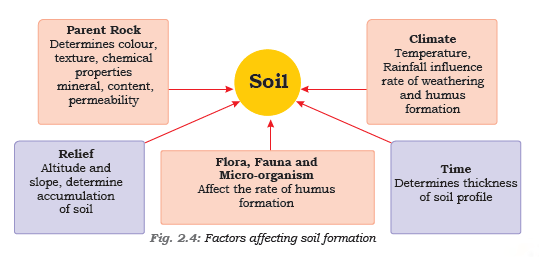
CBSE Class 8 Geography Notes Chapter 2: Chapter 2 of CBSE Class 8 Geography, "Land, Soil, Water, Natural Vegetation, and Wildlife Resources," explores the essential resources that support life on Earth. It discusses land use, soil formation, and the importance of soil fertility for agriculture. Water, a vital yet unevenly distributed resource, is crucial for drinking, farming, and industry.
CBSE Class 8 Geography Notes Chapter 2 also covers the significance of natural vegetation and wildlife in maintaining ecological balance. It emphasizes the need for sustainable management and conservation of these resources to ensure environmental stability and availability for future generations.CBSE Class 8 Geography Notes Chapter 2 Overview
Chapter 2 of CBSE Class 8 Geography, titled "Land, Soil, Water, Natural Vegetation, and Wildlife Resources," provides an overview of the Earth's vital resources and their significance for human life. The chapter emphasizes that land is a limited and unevenly distributed resource, used for various purposes such as agriculture, forestry, mining, and settlement. Soil, formed through the weathering of rocks, is essential for agriculture, and its fertility depends on factors like organic matter, minerals, and moisture. Water, a crucial resource, is unevenly distributed across the globe and is essential for drinking, agriculture, and industrial processes. The chapter highlights the importance of conserving water due to its scarcity in many regions. Natural vegetation and wildlife are vital components of the ecosystem, contributing to the balance of nature. The chapter discusses different types of vegetation, including forests, grasslands, and deserts, and stresses the importance of preserving these resources to maintain ecological balance and support biodiversity.CBSE Class 8 Geography Notes Chapter 2 PDF
CBSE Class 8 Geography Notes Chapter 2 concludes by emphasizing sustainable management and conservation of these resources to ensure their availability for future generations, highlighting the interconnectedness of all these resources in maintaining the Earth's environmental stability. Hence, here we have provided CBSE Class 8 Geography Notes Chapter 2 Land, Soil, Water, Natural Vegetation and Wildlife Resources pdf -CBSE Class 8 Geography Notes Chapter 2 PDF
CBSE Class 8 Geography Notes Chapter 2 Land, Soil, Water, Natural Vegetation and Wildlife Resources
Here we have provided CBSE Class 8 Geography Notes Chapter 2 Land, Soil, Water, Natural Vegetation and Wildlife Resources -Land
Land is a vital natural resource that makes up 30% of the planet's surface, albeit not all of it is livable. The different features of the terrain and climate are the reason for the uneven population distribution in some areas.| Areas that are sparsely populated or uninhabited | Densely populated areas |
|
|
Uses of Land
The land is put to many uses, including forestry, mining, construction of homes and roads, and the establishment of industries. This is referred to as land use. Physical elements that affect how land is used include terrain, soil, climate, minerals, and water supply. Human factors, such as population and technology, are what determine how land is used. Based on who owns it, land can also be divided into community and private categories. While community property is owned by the community for shared purposes like gathering fruits, nuts, fodder, or medicinal herbs, private land is owned by individuals. Community lands are also known as common property resources. The limited supply of land, despite the ever-increasing demands of people, has led to land encroachment in order to create shopping centres, commercial districts, and agricultural land expansion in rural and urban areas. Land degradation, landslides, soil erosion, and desertification are some of the serious risks brought on by the growth of agriculture and construction.Conservation of Land Resource
At all Large-scale degradation of the forest cover and other natural resources is caused by an increasing population and their expanding demands. In the interim, the following are typical techniques for protecting land resources:- Afforestation
- land reclamation
- regulated use of chemical pesticides and fertilisers
- checks on overgrazing
Soil
The earth's surface is covered in a thin layer of granular material that is intimately connected to the soil. The kind of soil is determined by landforms. Organic particles, minerals, and weathered rocks that have been exposed to the elements through time make up soil. Fertile soil has the proper balance of organic matter and minerals.Landslides
A landslip is a mass movement of rock, debris, or earth down a slope; it frequently occurs in tandem with volcanoes, floods, and earthquakes. A protracted period of rain is another factor that can trigger a landslip.Mitigation Mechanism
Scientific methodological advancements have enabled us to better understand the causes of landslides and how to control them. The following are some general landslip mitigation techniques: Locate landslide-prone locations with hazard mapping. Therefore, it is best to avoid developing communities in such places. building a retaining wall to prevent the ground from slipping Increasing the amount of plants to stop landslides The purpose of surface drainage control is to manage spring floods, precipitation, and landslip movement.Factors of Soil Formation
- The nature of the parent rock
- Climatic factors
- Topography
- Role of organic material
- Time taken for the composition of soil formation

Degradation of Soil and Conservation Measures
The two biggest risks to the soil as a resource are soil erosion and depletion. Soils can degrade due to natural or human-caused reasons. Among the elements that cause soil degradation are:- deforestation
- overgrazing
- overuse of chemical fertilizers or pesticides
- rain wash
- landslides and floods
Water
Water is one of the most important renewable natural resources on Earth, covering three quarters of its surface. Around two thirds of the earth's surface is made up of oceans, which are home to a diverse range of flora and fauna. It is salted, nevertheless, and unfit for human consumption. Only 2.7% of them are found in freshwater, while the remaining 70% are found in mountainous, Antarctic, and Greenland regions as ice sheets and glaciers that are inaccessible due to their location. Therefore, less than 1% of freshwater is fit for human usage. The volume of water in the earth is fixed and cannot be added to or removed from it. Its perpetual motion—cycling through the air, seas, and land and back again through the processes of evaporation, precipitation, and runoff—seems to be the only reason for its abundant fluctuations. You are already aware that this is known as the "water cycle."Problems of Water Availability
The availability of freshwater is insufficient in the majority of the planet. Water scarcity is a major issue for nations in climate zones most vulnerable to droughts. Therefore, variations in seasonal or yearly precipitation may result in a lack of water, or overexploitation and contamination of water sources may be the cause of the shortage.Conservation of Water Resources
In order to ensure that this material remains available for use, the following actions have been made to preserve it: The canopy of forests and other plants reduces surface runoff and replenishes subsurface water. Water harvesting is an additional technique to save surface runoff. It is important to correctly line the canals used for field irrigation in order to reduce water seepage losses. Sprinklers efficiently irrigate the land by preventing water loss from evaporation and seepage. Drip or trickle irrigation works exceptionally well in arid areas with high evaporation rates. It is consequently possible to preserve the precious water supply by using these irrigation techniques.Natural Vegetation and Wildlife
The biosphere is the small zone of contact between the lithosphere, hydrosphere, and atmosphere where natural flora and fauna are found. Living things in the biosphere depend on one another for survival and are related to one another. The ecology is this system that sustains life. Animals, birds, insects, and aquatic life forms are all considered to be part of the wildlife. In addition to feeding on insects, birds also serve as decomposers. Because it can consume dead animals, vultures are scavengers and are important environmental cleaners. Thus, all species, no matter how big or small, are essential to preserving the ecosystem's equilibrium.Distribution of Natural Vegetation
The two main factors that affect vegetation development are moisture content and temperature. The world's primary vegetation types are categorised as tundra, grasslands, scrubs, and forests. Large trees flourish in regions with high rainfall, and forests are therefore linked to regions with an abundance of water. In areas with moderate rainfall, the size and density of trees diminish as the amount of moisture declines, resulting in short, stunted trees and shrubs. In arid regions: Low-lying areas with thorny bushes and scrubs thrive.Conservation of Natural Vegetation and Wildlife
Natural habitats for plants and animals may disappear due to climate change and human activity. A number of man-made and natural phenomena, including deforestation, soil erosion, construction operations, forest fires, tsunamis, and landslides, contribute to the accelerated extinction of these resources. Poaching, which causes a sharp drop in the population of specific species, is another significant worry. The purpose of national parks, animal sanctuaries, and biosphere reserves is to safeguard the native flora and fauna. Wetlands, lakes, and creeks must be preserved to prevent the depletion of this priceless resource. At the regional and neighbourhood levels, awareness initiatives like social forestry and Vanamohatasava are being implemented. In order to foster an appreciation for the habitat of many species, schoolchildren are also encouraged to go to nature camps and observe birds. Numerous nations have enacted legislation prohibiting both the commerce and the killing of animals and birds. It is forbidden to kill peacocks, lions, tigers, deer, and great Indian bustards in India. In the meantime, the international convention known as CITES was created, listing a number of animal and bird species for which trade is forbidden.Benefits of CBSE Class 8 Geography Notes Chapter 2
The benefits of studying CBSE Class 8 Geography Chapter 2, "Land, Soil, Water, Natural Vegetation, and Wildlife Resources," include:Understanding Resource Management : The chapter teaches the importance of managing and conserving essential natural resources like land, soil, water, vegetation, and wildlife, which are crucial for sustaining life on Earth.
Awareness of Environmental Issues : It helps students become aware of environmental challenges such as soil erosion, water scarcity, deforestation, and biodiversity loss, encouraging responsible actions to address these issues.
Promotes Sustainable Practices : The chapter emphasizes sustainable use of resources, fostering a sense of responsibility towards the environment and encouraging practices that ensure the long-term availability of these resources.
Foundation for Future Studies : It lays the groundwork for understanding more complex geographical concepts in higher classes, providing a solid base for future studies in environmental science, geography, and related fields.
Holistic Learning : By integrating topics related to physical geography, ecology, and conservation, the chapter provides a well-rounded understanding of how natural resources support life and how human activities impact them.
CBSE Class 8 Geography Notes Chapter 2 FAQs
What is natural vegetation class 8 notes?
What are land resources class 8 notes?
What are natural resources Class 8 notes?
What are soil class 8 notes?









